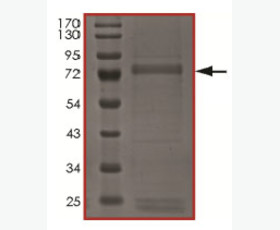Recombinant Human Profilin-2/PFN2
| Product name: | Recombinant Human Profilin-2/PFN2 |
| Source: | E. coli |
| Purity: | Greater than 95% as determined by reducing SDS-PAGE. |
| Buffer Formulation: | Lyophilized from a 0.2 μm filtered solution of 20mM Tris,150mM NaCl,pH 8.0. |
| Applications: | Applications:SDS-PAGE; WB; ELISA; IP. |
| Storage: | Avoid repeated freeze/thaw cycles. Store at 2-8 oC for one month. Aliquot and store at -80 oC for 12 months. |
| UOM: | 100ug/50ug/200ug/1mg/1g |
| Source | E. coli |
| Description | Recombinant Human Profilin-2 is produced by our E.coli expression system and the target gene encoding Met1-Phe140 is expressed. |
| Names | Profilin-II, PFN2, Profilin-2, PFL |
| Accession # | P35080 |
| Formulation | Lyophilized from a 0.2 μm filtered solution of 20mM Tris,150mM NaCl,pH 8.0. |
| Shipping |
The product is shipped at ambient temperature. |
| Reconstitution |
Always centrifuge tubes before opening. Do not mix by vortex or pipetting. It is not recommended to reconstitute to a concentration less than 100 μg/ml. Dissolve the lyophilized protein in ddH2O. Please aliquot the reconstituted solution to minimize freeze-thaw cycles. |
| Storage |
Lyophilized protein should be stored at < -20°C, though stable at room temperature for 3 weeks. Reconstituted protein solution can be stored at 4-7°C for 2-7 days. Aliquots of reconstituted samples are stable at < -20°C for 3 months. |
| Purity |
Greater than 95% as determined by reducing SDS-PAGE. |
| Endotoxin | Less than 0.1 ng/µg (1 IEU/µg) as determined by LAL test. |
| Amino Acid Sequence |
MAGWQSYVDNLMCDGCCQEAAIVGYCDAKYVWAATAGGVFQSITPIEIDMIVGKDREGFFTNGLA LGAKKCSVIRDSLYVDGDCTMDIRTKSQGGEPTYNVAVGRAGRVLVFVMGKEGVHGGGLNKKAYS MAKYLRDSGF
|
| Background | Profilin-II (PFN2) is ubiquitous protein which belongs to the profilin family. PFN2 binds to actin, thenaffects the structure of the cytoskeleton. At high concentrations, profiling prevents the polymerization of actin, while increases that at low concentrations. PFN2 is a ubiquitous actin monomer-binding protein. It regulates actin polymerization in response to extra cellular signals. PFN2 binds to PIP2; it inhibits the formation of IP3 and DG. |














